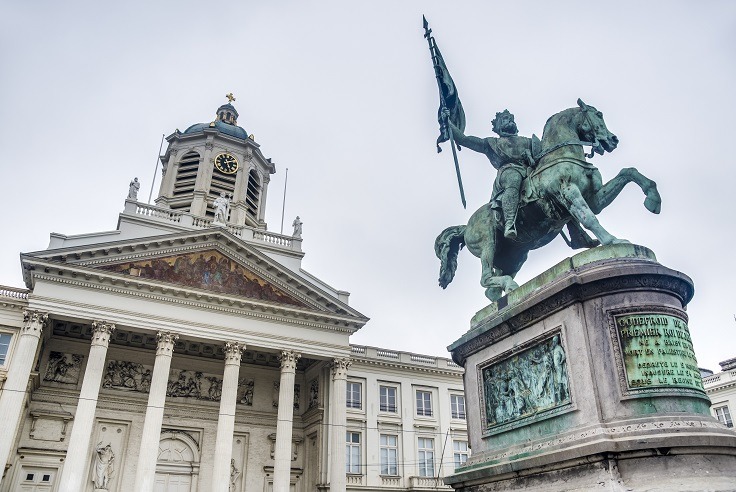Godfrey of Bouillon (ca 1060–1100) was duke of Lower Lorraine and had his name linked to a castle in the Belgian Ardennes. He was one of the leaders in the first Crusade in 1096–1099, answering to the call of pope Urban II to liberate the Church of the Holy Sepulchre in Jerusalem.
As the first ruler of the Crusader state in Jerusalem, he was glorified in mediaeval chronicles and legends as a Christian knight without fear and reproach. When the Belgian kingdom was established after the rebellion in 1830 against King William I of the United Kingdom of the Netherlands, Godfrey was resurrected as a unifying force in a kingdom divided by language and class.
An impressive equestrian statue of Godfrey (in French Godefroid) can be seen at Place Royal in Brussels and reminds us of the attempt of the newborn Belgian kingdom to create a national consciousness based on a glorious past. The statue was inaugurated in August 1848 in the presence of king Leopold I and his government. Leopold, a prince from Saxe-Coburg in Germany and a relative of the British royal house, had been accepted as king of Belgium by the major European powers.
Charles Rogier, a revolutionary from 1830 and prime minister and minister of interior from the liberal party, exclaimed: “Let the national pantheon open to receive a new guest. Make room for Godfrey of Bouillon! Let the hero show himself.” Never mind that the inscription on the fundament of the statue – still to be read – is misleading and that this must have been known to some of the historians of the time. Godfrey was neither a Belgian duke, with alleged birthplace at Baissy in Brabant, nor a king of Jerusalem.
Godfrey was probably born in Boulogne-sur-Mer, France, the second son of Count Eustace II of Boulogne. He inherited the castle of Bouillon from his uncle Godfrey the Hunchback who had been killed in 1076. When he was appointed duke of Lower Lorraine in 1089 by the German king Henry IV, also Holy Roman Emperor, he became his vassal. As the other leading counts, dukes and princes in the Princes’ crusade, which followed the failed People’s crusade in 1096, Godfrey was considered a “Frank” (originally Germanic tribes who settled in France and gave it its name).
“Belgica”, the name of a former Roman colony, would resurrect only in 1830. It does not exclude that some form of separate identity existed for centuries in the territory, which now constitutes Belgium, despite the language barrier.
Godfrey’s duchy Lower Lorraine or Lotharingia was part of a previous kingdom named after Lothar, a grandson of Charlemagne. This middle kingdom, born by the collapse of Charlemagne’s empire, was divided in 953 into two entities, which covered parts of present-day Belgium, the Netherlands, France and Germany. Godfrey was indeed one of the first to break the walls of the besieged city of Jerusalem on 15 July 1099, but he was never appointed king of what would become the Crusader Kingdom of Jerusalem.
He was elected as Advocate or Defender of the Holy Sepulchre, allegedly refusing to be named king in the city where Christ had been crucified. As a result he accepted the tutelage of the Pope, who passed away before the news about the capture of Jerusalem could reach him.
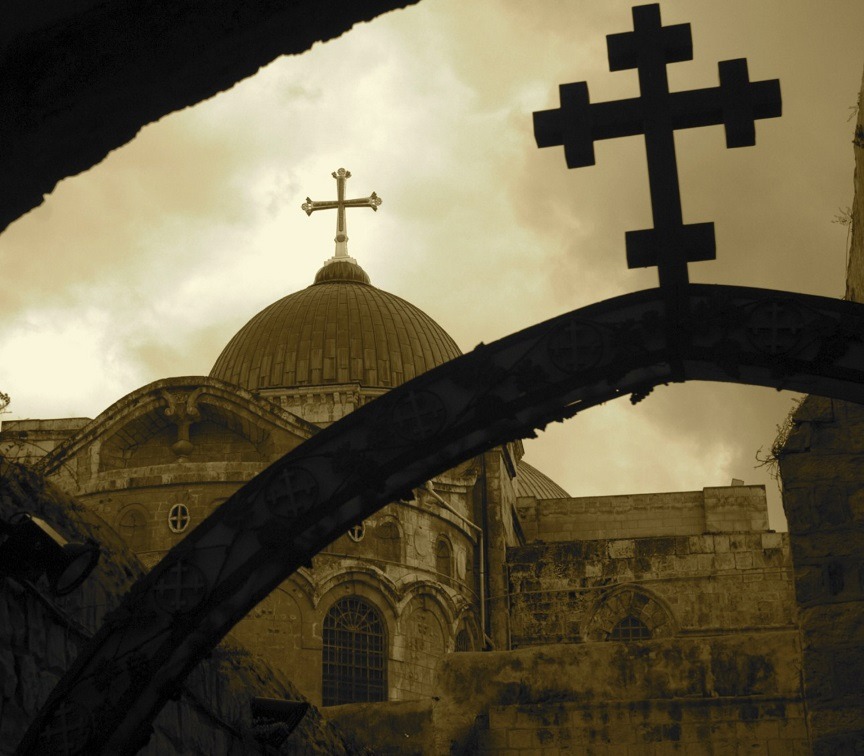
The Church of the Holy Sepulchre in Jerusalem
Following Godfrey’s death on 17 July 1100, his brother Baldwin, who had become Count of Edessa, in present-day south-east Turkey, and who had stayed behind when the crusader army continued its exhausting march to Jerusalem, was appointed the first king.
A new kingdom in need of a symbol
The Belgian kingdom in the 19th century was desperately in need of a national symbol that could make Belgians feel proud of their country and support the new monarchy as unifying glue.
Who could better serve as such a symbol than Godfrey of Bouillon if we are to believe William of Tyre? In his chronicle of Outremer, the crusader states, written around 1180 and considered for centuries as the single most influential history of the first Crusade, the archbishop of Tyre portrayed Godfrey as follows:
"He was a religious man, mild mannered, virtuous, God-fearing. He was just, he avoided evil, and he was trustworthy and dependable in his undertakings.... He was considered by everyone to be most outstanding in the use of weapons and in military operations."
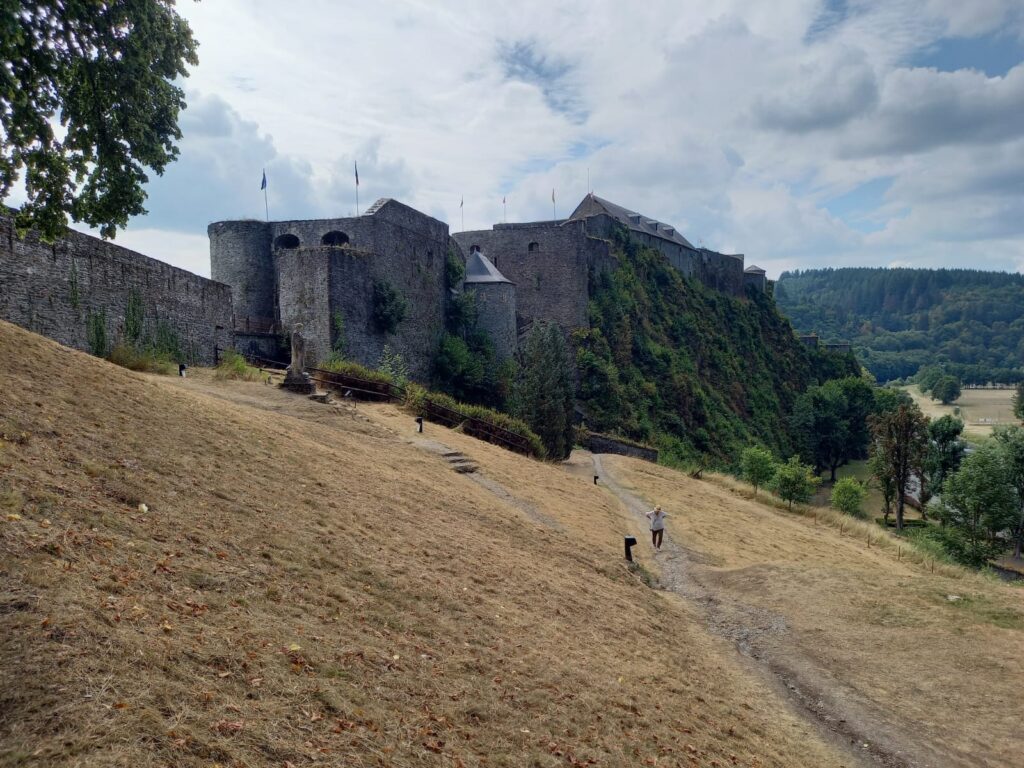
The Godfrey Castle in Bouillon
No doubt this chronicle was still considered a trustworthy source when the Belgian kingdom was created. At that time the kingdom could be considered an artificial construction aimed at preserving the power balance in Europe after the Napoleonic wars. There was hardly any common identity binding together the Dutch-speaking northern part Flanders and the French-speaking southern part Wallonia.
There were still political movements in Belgium who favoured reunification with France or the Netherlands. Belgium was in the process of an economic transformation from an agrarian to an industrial country. The years between 1830 and 1848 were a decisive period when the remnants of the ancient regime, dominated by the land-owning aristocracy and the clergy, were forced to adapt themselves to the needs of the new society. The new constitution was modern for its time and a compromise between the old forces and the liberal middle class.
Those who had fought for a revolution, which would result in equal rights for all citizens, had reason to be disappointed. Voting rights depended on tax paying thresholds and limited the electorate to one percent of the population. The role of the new king was controversial. He was granted powers, which exceeded what we today would call a constitutional monarchy in which the monarch has purely ceremonial tasks. Belgium was spared the February revolution in 1848 but remained a deeply divided country.
The Belgian monarchy has since then undergone ups and downs but it still fulfils a unifying function in a federal country, which from time to time seems to be on the brink of a break-up. The image and role of Godfrey has been reviewed in modern historical research but continues to stir ideological controversy. This is not unusual and special for Belgium. It happens quite often that kings in the past, who were considered national heroes, are reassessed either because of new historical sources or a change in criteria and values.
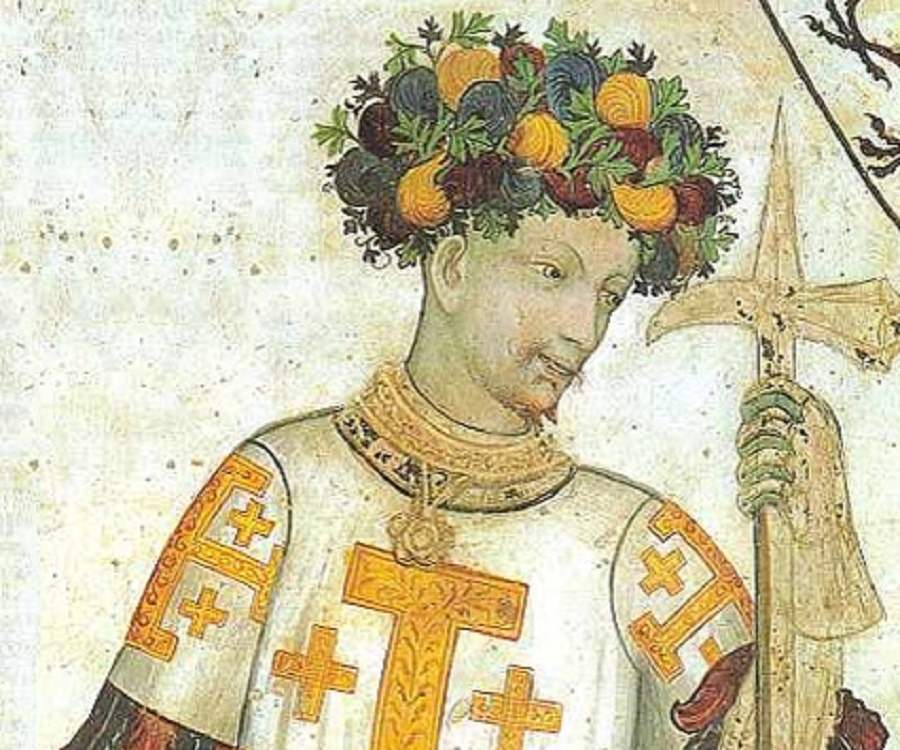
Fresco of Godfrey of Bouillon in the Church of Augusta Victoria on the Mount of Olives in Jerusalem
Should a historical person be judged by today’s yardstick or by the values and behaviour of his time? If we choose the second option, we need to examine the values in the past. But even then, we would not glorify that person if those values differed from our own values today.
The Crusades as armed pilgrimages
In the case of Godfrey of Bouillon, the historical sources, in the form of clerical chronicles, were overwhelmingly positive. This is not surprising as the authors often described the perspective of a particular leader and expressed the Christian belief at the time in the justification of the Crusades as a “holy war” to liberate the lands occupied by the Muslims and enable Christian pilgrims to travel safely to the land of Christ. This was later to become the stuff of popular legends and poems known as “chansons de geste,” where Godfrey’s ancestry was traced back to Charlemagne.
Many crusaders, probably also Godfrey of Bouillon, were no doubt deeply religious and shared this belief, in particular as the Pope had promised them absolution of their sins. In this sense, as Jonathan Riley-Smith shows in his book “The First Crusade and the Idea of Crusading” (1986), the Crusades, at least the first one, can best be described as armed pilgrimages and an attempt to purify and unify Christian society through a “holy war”. In addition secular factors played an important role.
The Crusades took place in the context of the on-going struggle between the Muslim and Christian world. The first Crusade was a response to the Byzantine emperor’s call for support. The Pope did not allow Spanish knights to join the crusade–their priority was to reconquer the lands in the Iberian Peninsula. Furthermore, Western Europe was suffering because of violence and lawlessness caused by rivalling fiefdoms and weak kingdoms. There was an excess of warlords and landless knights who made a living as mercenaries.
For the sake of peace, you had to get rid of them and what better way was there than sending them far away on a Crusade? Godfrey of Bouillon followed the instruction of the Pope and departed wisely in August 1096–after the harvest–as head of a mighty army of knights and foot soldiers. To finance his expedition, he sold some of his property including his castle with a repurchase agreement. He accepted bribes from the Jewish communities in the Rhineland but did not protect them when they were assaulted during the Peasants’ or People’s Crusade in May-June 1096.
Godfrey might have been greedy but he can hardly be held responsible for the massacres and forced conversions which took place in Speyer, Worms, Mainz and other cities along the way of the Peasant’s crusade, under Peter the Hermit, a monk from Amiens, or his disciples and Count Emicho of Leiningen, a south-German knight. According to Norman Davies in “Europe A history” (1996), even contemporaries found the conduct of the Crusaders shocking.
The assaults, which contradicted the teachings of the Church–no-one should be forced to convert to Christianity–resulted in the murder of thousands of Jews and in voluntary martyrdom by whole families for the sanctification of God’s name.
A curse on Godfrey of Bouillon
There were instances of armed resistance but to no avail. The events that took place in the Jewish communities have come down to us in Hebrew chronicles and inspired Jewish mourning liturgy in memory of the destruction of the Temple. These chronicles have been considered by historians as historical texts. The latest trend, according to Judith Bronstein in the anthology “Jerusalem the Golden, The Origins and Impact of the First Crusade” (2014), is to examine them as literary texts with an ideological message.
The oldest and most detailed of these chronicles, by Solomon bar Simson, is based on eyewitness accounts and was written around 1140. According to Shlomo Eidelberg, who translated them into English (1977), they present a coherent narrative. The literary influence of the Bible is perceptible and so is also the use of derogatory references to Christianity.
According to Solomon bar Simpson, the Crusaders took a vow: “We are going a long way to seek out the profane shrine (Church of the Holy Sepulchre) and to avenge ourselves on the Ishmaelite (Muslims), when here in our very midst are the Jews–they whose forefathers murdered and crucified him (Christ) for no reason. Let us first avenge ourselves on them and exterminate them from among the nations so that the name of Israel will no longer be remembered, or let them adopt our faith...”. Religious fanaticism and the lust to plunder entered into an unholy alliance.
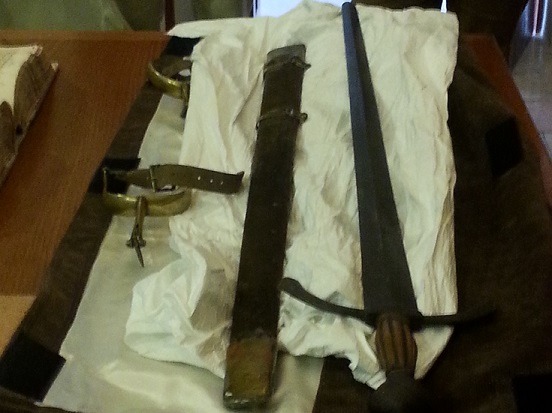
Godfrey’s of Bouillon sword and spurs at the library of the Franciscan monastery of Saint Saviour in Jerusalem
A crucial paragraph in the chronicle curses a Duke Gottvart which is the Flemish name of Godfrey of Bouillon: “It was at this time that Duke Godfrey, may his bones be ground to dust, driven by a spirit of wantonness to go with those journeying to the profane shrine, vowing to go this journey only after avenging the blood of the crucified one (Christ) by shedding Jewish blood and completely eradicating any trace of those bearing the name ‘Jew’, thus assuaging his own burning wrath on us.” The chronicle continues:
“The king (Henry IV) was enraged and ordered all ministers, bishops and governors as well as Duke Godfrey not to do bodily harm to the Jews and to provide them with help and refuge. The evil Duke then swore that he had never intended to do them harm. The Jews of Cologne nevertheless bribed him with five hundred silver coins, as did the Jews of Mainz. The Duke assured them of his support and promised them peace. However, God, the maker of peace, turned aside and averted his eyes from the people and consigned them to the sword.”
During the journey to the Holy Land, Godfrey of Bouillon showed proof of diplomatic skills. He managed to pass peacefully through Hungary, that defended its borders and had annihilated undisciplined armies in the Peasants’ Crusade, and to obtain the permission of the Emperor in Constantinople to cross the Bosphorus to Minor Asia to regain lost Byzantine territories.
What played to the advantage of the Crusaders was the internal divide among the Muslims. After many hardships, where the crusaders were often short of money and horses, they finally arrived, though heavily reduced in numbers, on 7 June 1099, at the gates of Jerusalem.
Massacre in Jerusalem
The city was heavily fortified and defended by a Fatimid garrison from Egypt and its Jewish and Muslim inhabitants. The first assault failed. But thanks to the arrival of ships to Yaffa, the Crusaders were able to build siege machines and assault towers.
After a procession around the city walls on 8 July, in reminiscence of the Biblical story of the capture of Jericho, the Crusaders managed to break the defence on 15 July. Most of the sources agree that the first crusader to mount the walls was a knight called Letold of Tournai, fighting in a siege tower commanded by Godfrey of Bouillon.
“The image of Godfrey was idealised in the Christian tradition and he became one of the most celebrated figures in medieval history,” history professor Iris Shagrir at the Open University of Israel tells The Brussels Times. “But in Jewish-Muslim history, Godfrey is remembered for the massacre which took place in Jerusalem after the fall of the city in 1099. It happened that Godfrey broke through the part of the walls, which were defended by the Jews, located in the northeastern part of the city.”
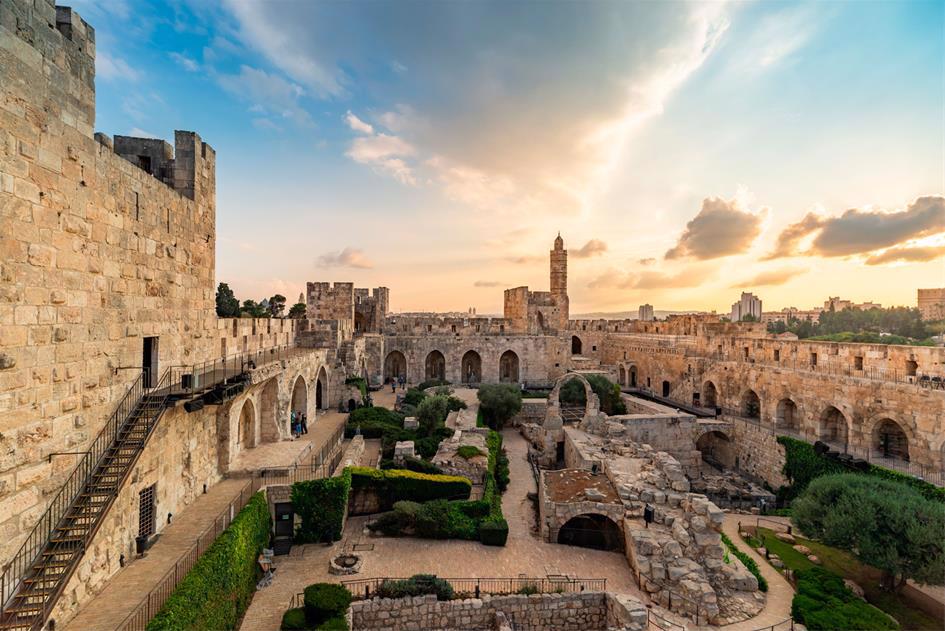
The Ancient citadel and Tower of David in Jerusalem
According to Gesta Francorum, a chronicle written by an anonymous writer who had participated in the Crusade, “our men were killing and slaying even to the Temple of Solomon, where the slaughter was so great that our men waded in blood up to their ankles.”
The city was full of corpses. Some Jews and Muslims were spared for ransom and the garrison at the Tower of David surrendered in exchange for free conduct.
In the end, it is impossible to assess the extent of Godfrey’s role in the massacre of thousands of Muslims and Jews. If we are to believe the chronicles, he did not participate in the killings but went unarmed and barefoot around the ramparts and went to pray at the Church of the Holy Sepulchre. The massacre continued for three days according to the chronicle of Albert of Aachen. According to Alain Murray in “Jerusalem the Golden” (2014), his chronicle contains the most lengthy account of the siege and capture of Jerusalem and has been re-established as the most important source.
Image of Godfrey of Bouillon
The old image of Godfrey may still be presented in Bouillon where his castle is open for visitors and where a special museum, Archéoscope Godefroid de Bouillon, aims at recreating the first Crusade in his company. But in popular history writing in Belgium, his image has already been reviewed.
In 1995, a book called “Les Grands Myths de L’historie de Belgique” was published, edited by Professor Anne Morelli at the Free University of Brussels (ULB). The purpose was to “demystify” a number of myths relating to the Belgian nation and the monarchy.
One chapter, by Isabelle Wanson, was dedicated to Godfrey of Bouillon and concluded that the myth about him had survived for so long because it fit into a romantic and patriotic ideology.
Godfrey was seen as a true Belgian in history books, which ignored critical research. Anne Morelli tells The Brussels Times that the book caused a scandal but because of all the publicity, it became a bestseller. “I really think that it profoundly changed public opinion,” she says. “It’s impossible to continue to present Godfrey as a hero in the history books.”
Another more recent book, “Sur les Traces de Godefroid de Bouillon” (2015), by Jean-Louis Lahaye in cooperation with Jean-Michel Bodelet, is based on a series for Belgian television (RTBF) on historical figures.
Relying on the works of chroniclers and historians the book follows Godfrey’s dramatic life from Bouillon to Jerusalem–again in an attempt to demystify him. “Living in La Roche-en-Ardenne, I’m surrounded by castles from the time of Godfrey of Bouillon,” Jean-Michel Bodelet tells The Brussels Times.
“The book is a kind of a synthesis of what we know about Godfrey’s complex personality and political vision as duke of Lower Lorraine,” he continues. “I’m trying to show that he was a prince of his time. He was considered a national Belgian hero in old textbooks and identified with the ‘nationalistic’ Belgian idea in the 19th century. But it’s obvious that he didn’t feel as a Belgian. History needs heroes and founding myths. For Belgium, during the 19th century, it was important to look for great figures from the past with a connection to its territory.”
What is myth and reality? “I think, unfortunately, that it’s common to criticize the past and its figures. But to regard the past with our contemporary eyes is a mistake. It’s obvious that Godfrey wasn’t the hero described in the chronicles and the text books in history. He was a person of his time, with its faults and his own faults, involved as a witness and actor in the struggle between emperor and pope on the right to nominate bishops, the feudal power struggles in Lower Lorraine and the first Crusade.”
Albert of Aachen may also be the only source to provide a rational explanation for the massacre besides the theological ones of taking revenge and spilling Jewish and Muslim blood.
According to medieval conventions of war, besieged populations could secure their lives by surrendering. But they could not expect any mercy if a city was taken by assault, which was the case in Jerusalem. And the massacre in Jerusalem was an orgy of violence and lasted for three days.
Following the capture of Jerusalem, The Crusaders were exhausted and had been reduced to around 10 000 men. They expected to be attacked by a Muslim army advancing from Egypt and feared that the surviving enemy inside Jerusalem could become a fifth column. The historian Benjamin Kedar, in “Jerusalem the Golden” (2014), quotes Albert of Aachen who provides the following explanation: “For if we were to be attacked in great strength by the king of Egypt we should be suddenly overcome from the inside and outside of the city.”
The legacy of Godfrey of Bouillon
The calculation was proven to be correct. Godfrey of Bouillon proved himself again in battle. He went out of Jerusalem with the Crusader army and defeated the Egyptian army at the battle of Ascalon on 12 August 1099. A year later he fell ill after another battle at Acre and died.
But the myth of Godfrey of Bouillon lingered on and continued to inspire other crusaders. Léon Degrelle, born in Bouillon in 1906, founded the far-right Rexist party in the 30s and became a Nazi collaborator, who joined Waffen SS during the Second World War in a “crusade” against “Judeobolshevism”.
Not only was Belgium affected by the myth. In 1898, the German emperor Wilhelm II visited Jerusalem. He tried to expand German power to the country, then under Ottoman rule, and built churches and hospitals in Jerusalem.
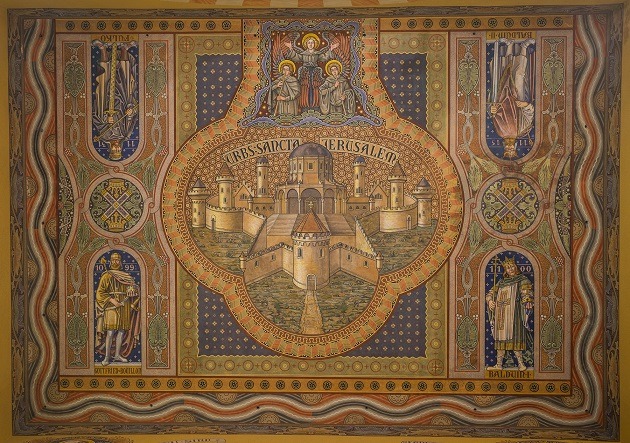
Fresco in the Church of Augusta Victoria on the Mount of Olives in Jerusalem showing the first Crusader kings
A fresco in the Church of Augusta Victoria on the Mount of Olives in Jerusalem shows the first four Crusader kings, including Godfrey. Wilhelm II – perhaps more than any other European ruler responsible for the outbreak of the First World War – considered himself a follower of Godfrey and the fresco can be seen as a symbolic gesture.
Godfrey’s sword and spurs are kept at the library of the Franciscan monastery of Saint Saviour in Jerusalem. If they really belonged to him cannot be verified, but they do seem to date from the 11-th century.
Godfrey was buried in the Church of the Holy Sepulchre. There his tomb together with other Crusader tombs remained until a fire struck the church in 1808. The church was renovated but the tombs disappeared. May he rest in peace without his memory being manipulated for political purposes.

